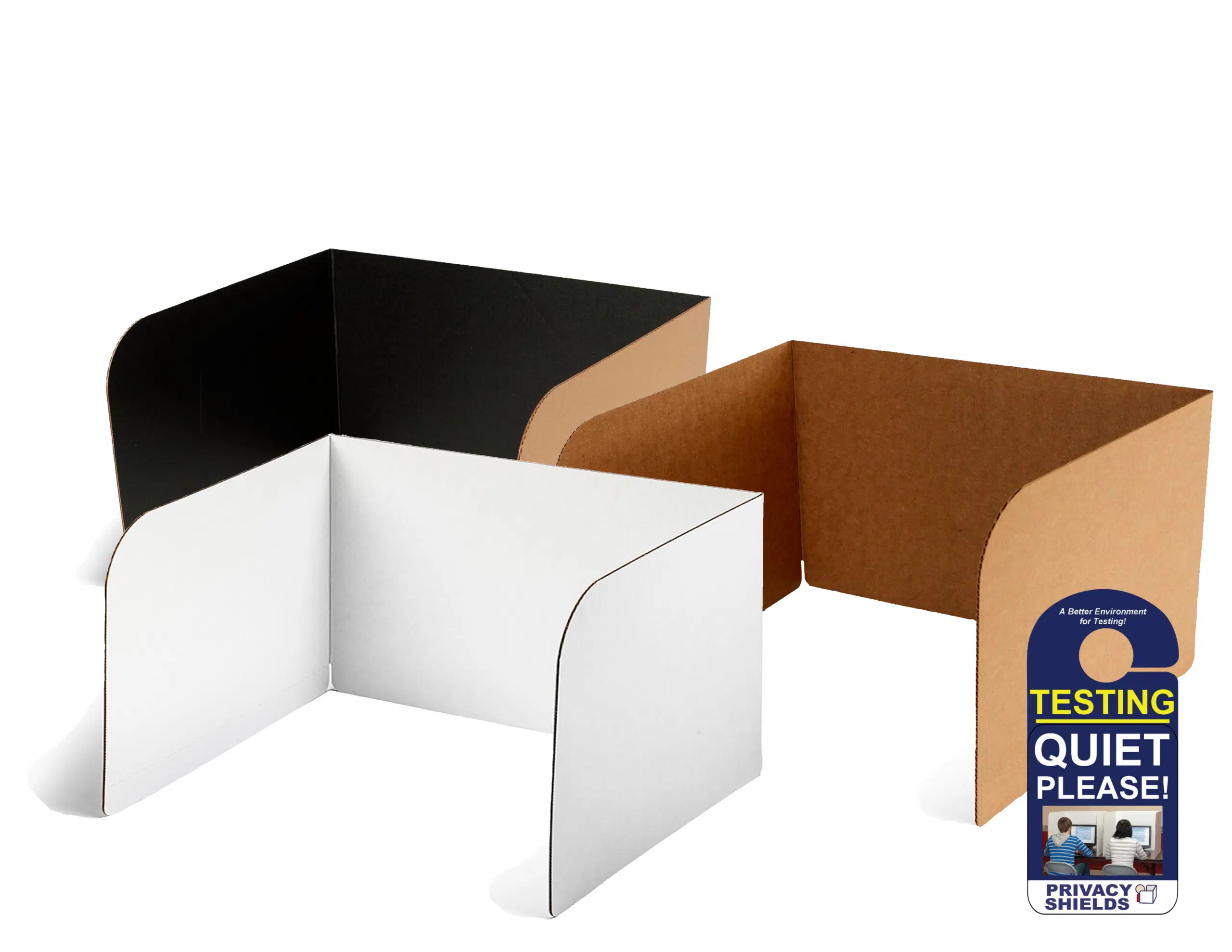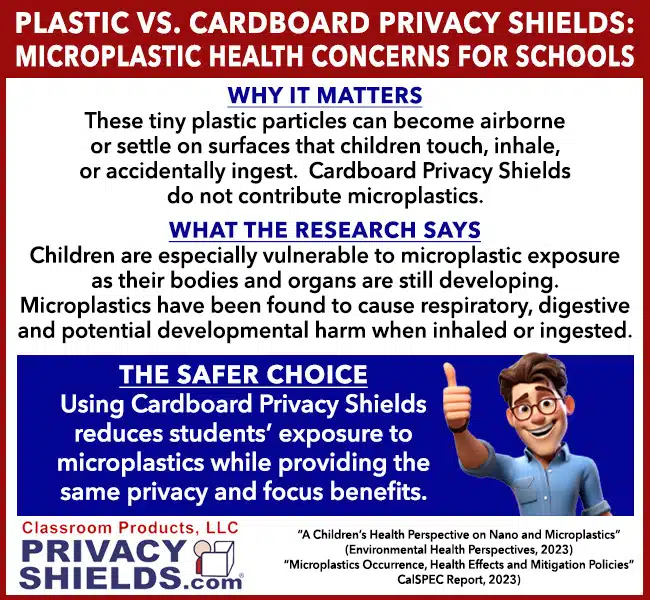
The Hidden Threat: Safe Cardboard Privacy Shields vs. Plastic
The Hidden Threat: Microplastics in Schools and the Case for Safe Cardboard Privacy Shields
Prepared for PrivacyShields.com (Classroom Products LLC).
Your #1 Source for Cardboard Privacy Shields Since 2003.
Executive Summary
The proliferation of plastic materials in educational environments poses an unprecedented threat to student health through microplastic exposure. This comprehensive report examines the harmful effects of microplastics on school-aged children and presents compelling evidence for replacing plastic privacy shields with safer cardboard alternatives. Current research reveals that microplastics cause oxidative stress, DNA damage, organ dysfunction, neurotoxicity, and developmental toxicity in children. The transition from plastic to cardboard privacy shields represents a critical intervention point to protect student health while maintaining educational functionality.
Introduction
Microplastics, defined as plastic particles smaller than 5 millimeters, have become ubiquitous in educational environments. These microscopic particles originate from the degradation of plastic products commonly used in classrooms, including privacy shields, furniture, supplies, and electronic device casings. Children are particularly vulnerable to microplastic exposure due to their developing organ systems, higher respiratory rates, and increased hand-to-mouth behaviors.
The classroom environment, where students spend approximately 6-8 hours daily for 180+ days annually, represents a significant exposure pathway for microplastics. Privacy shields, used extensively during testing and individual work, are in direct contact with students’ breathing zones and frequently touched surfaces, making them a primary source of microplastic exposure.
The Science of Microplastic Toxicity in Children
Mechanisms of Harm
Recent scientific evidence demonstrates that microplastics cause multiple forms of cellular and systemic damage in developing organisms. The toxic effects manifest through several interconnected mechanisms that are particularly concerning for school-aged children.
Microplastics induce oxidative stress at the cellular level, overwhelming the natural antioxidant defense systems in children’s developing bodies. This oxidative damage disrupts normal cellular function and can trigger inflammatory cascades throughout the body. The particles also cause direct DNA damage, potentially leading to long-term genetic instability and increased cancer risk later in life.
The cardiovascular system shows particular vulnerability to microplastic exposure. Research has documented significant cardiovascular impacts, with patients having microplastics in their arterial plaque showing a 450% increased risk of heart attack, stroke, or death. While this data comes from adult populations, the implications for children exposed during critical developmental windows are deeply concerning.
Neurological and Cognitive Impacts
The developing nervous system represents the most vulnerable target for microplastic toxicity in school-aged children. Microplastics can cross the blood-brain barrier, accumulating in neural tissue and disrupting normal brain development. This neurotoxicity manifests in multiple ways that directly impact educational outcomes.
Children with higher microplastic exposure demonstrate delayed cognitive development, impaired language skills, attention deficits, and working memory challenges. These effects are particularly pronounced during the critical developmental windows that correspond to elementary and middle school years. The particles interfere with neurotransmitter function and can disrupt the formation of neural networks essential for learning and academic performance.
Prenatal and early childhood exposure to plastic-associated chemicals, which accompany microplastic particles, has been linked to reduced IQ scores, increased hyperactivity, and impaired executive function. These effects persist throughout childhood and can impact lifelong learning capacity and academic achievement.
Endocrine Disruption and Developmental Toxicity
Microplastics act as carriers for endocrine-disrupting chemicals (EDCs) including phthalates, bisphenol A (BPA), and other plastic additives. These chemicals leach from microplastic particles once inside the body, causing widespread hormonal disruption during critical developmental periods.
The endocrine system governs growth, development, metabolism, and reproductive maturation in children. Microplastic-associated EDCs interfere with these processes, potentially causing irreversible changes in reproductive development, metabolic function, and immune system maturation. Early exposure during childhood can program long-term health problems including obesity, diabetes, and reproductive dysfunction.
Studies have documented that children exposed to higher levels of plastic-associated chemicals show altered patterns of pubertal development, changes in growth trajectories, and increased risk of metabolic disorders. The school environment represents a controllable exposure source that can be modified to reduce these risks.
Respiratory System Impacts
The respiratory system serves as a primary entry point for airborne microplastics in classroom environments. Children have higher respiratory rates than adults and spend significant time in close proximity to plastic materials that shed microparticles into the air.
Inhaled microplastics lodge in lung tissue, causing inflammation and potentially interfering with normal respiratory development. The particles can trigger asthmatic responses and may contribute to the increasing prevalence of childhood respiratory disorders. Long-term accumulation of microplastics in lung tissue represents a largely unknown health risk with potentially serious consequences for lifelong respiratory health.
Privacy Shields: A Critical Exposure Source
Plastic Privacy Shield Hazards
Plastic privacy shields represent a particularly concerning source of microplastic exposure in educational settings. These products are positioned directly in students’ breathing zones during use, creating optimal conditions for inhalation exposure. The shields undergo continuous mechanical stress from handling, folding, and cleaning, which accelerates the release of microplastic particles.
Common plastic privacy shields are manufactured from corrugated plastic materials that contain various chemical additives including plasticizers, stabilizers, and colorants. These additives enhance microplastic toxicity by providing additional pathways for cellular damage. The corrugated structure of plastic shields creates numerous surfaces where microparticles can accumulate before becoming airborne.
Temperature fluctuations in classrooms accelerate plastic degradation, increasing microplastic generation from privacy shields. The repeated cleaning protocols required in educational settings further stress the plastic materials, promoting particle release. Studies indicate that mechanical abrasion from cleaning can increase microplastic shedding by orders of magnitude.
The cumulative exposure from plastic privacy shields is significant when considering the frequency and duration of use. Students may use these shields for multiple hours during testing periods, creating sustained exposure in confined breathing spaces. The proximity to the face and respiratory system maximizes inhalation potential.
Chemical Leaching and Off-Gassing
Plastic privacy shields continuously release volatile organic compounds (VOCs) and other chemical additives into the classroom air. These chemicals can cause immediate symptoms including headaches, eye irritation, and respiratory discomfort while contributing to long-term health risks through chronic exposure.
The off-gassing process is accelerated by classroom conditions including elevated temperatures, fluorescent lighting, and air circulation patterns. Chemical emissions from plastic shields create a localized exposure zone around each student, concentrating harmful compounds in the breathing space.
Phthalates, commonly used as plasticizers in corrugated plastic products, are of particular concern for student health. These chemicals are readily absorbed through inhalation and dermal contact, contributing to the body burden of endocrine-disrupting compounds. Classroom studies have documented elevated phthalate levels in environments with extensive plastic product use.
The Cardboard Alternative: Safety and Sustainability
Inherent Safety Profile
Cardboard privacy shields offer a fundamentally safer alternative to plastic products for classroom use. Manufactured from natural cellulose fibers, cardboard does not contain the synthetic polymers that degrade into microplastic particles. The absence of plastic-based materials eliminates the primary source of microplastic exposure from privacy shields.
The manufacturing process for cardboard privacy shields avoids the chemical additives commonly found in plastic products. While some adhesives and treatments are used in cardboard production, these are typically derived from natural sources and do not pose the same health risks as plastic additives. The corrugated cardboard structure provides equivalent functionality to plastic alternatives while maintaining superior safety profiles.
Cardboard privacy shields do not undergo the same degradation processes that generate microplastics from synthetic materials. The natural fiber structure may shed minimal cellulose particles, but these are biodegradable and do not accumulate in body tissues like synthetic microplastics. Any particles released from cardboard materials are readily processed by natural biological systems.
Reduced Chemical Exposure
The chemical profile of cardboard privacy shields presents significantly lower health risks compared to plastic alternatives. Natural cellulose fibers do not require the extensive chemical treatment needed for plastic production, reducing the potential for harmful chemical exposure.
Cardboard privacy shields do not off-gas volatile organic compounds at the levels associated with plastic products. The absence of plasticizers, stabilizers, and other synthetic additives eliminates major sources of indoor air pollution in classroom environments. This reduction in chemical exposure can improve overall classroom air quality and reduce symptoms associated with poor indoor environmental quality.
The water-based adhesives and treatments used in cardboard production are generally recognized as safe for educational environments. These materials do not contain the phthalates, BPA, or other endocrine-disrupting chemicals that are commonly found in plastic privacy shields.
Performance and Functionality
Modern cardboard privacy shields are engineered to provide equivalent or superior performance compared to plastic alternatives. High-quality corrugated cardboard offers excellent structural integrity while maintaining the flexibility needed for classroom use. The material can withstand normal classroom handling while providing reliable privacy protection during testing and individual work periods.
Cardboard privacy shields are available in multiple sizes and configurations to meet diverse educational needs. The material can be easily customized with educational graphics, color coding, or instructional materials to enhance learning outcomes. This versatility allows educators to integrate privacy shields into broader pedagogical strategies.
The lightweight nature of cardboard privacy shields facilitates easy handling by students of all ages. The material is less likely to cause injury during use and storage compared to rigid plastic alternatives. The reduced weight also simplifies classroom management and storage requirements.
Environmental Benefits
Cardboard privacy shields offer significant environmental advantages that align with educational sustainability goals. The materials are sourced from renewable forest resources that can be sustainably managed through responsible forestry practices. This renewable source material contrasts sharply with the fossil fuel dependence of plastic alternatives.
The biodegradable nature of cardboard ensures that privacy shields can be safely disposed of at the end of their useful life without contributing to long-term environmental pollution. Plastic privacy shields persist in the environment for hundreds of years, continuing to shed microplastics throughout their extended decomposition process.
Cardboard privacy shields are fully recyclable through existing paper recycling infrastructure. This closed-loop system reduces waste generation and supports circular economy principles in educational procurement. The recyclability of cardboard products provides educational opportunities for teaching environmental stewardship and sustainability concepts.
Health Impact Analysis: Comparative Risk Assessment
Immediate Health Effects
The immediate health impacts of microplastic exposure in classroom environments manifest through multiple physiological pathways. Students using plastic privacy shields may experience acute symptoms including respiratory irritation, eye discomfort, and cognitive fatigue due to chemical off-gassing and airborne particle exposure.
Cardboard privacy shields eliminate these immediate exposure pathways, creating healthier classroom environments for learning. The absence of chemical off-gassing reduces the risk of acute respiratory symptoms and sensitivities that can interfere with academic performance. Students with asthma or other respiratory conditions particularly benefit from reduced airborne irritants.
The improved air quality associated with cardboard privacy shields can enhance cognitive function and attention span during testing and individual work periods. Research demonstrates that reduced exposure to airborne pollutants correlates with improved academic performance and reduced absenteeism due to health-related issues.
Long-term Health Implications
The long-term health implications of childhood microplastic exposure are becoming increasingly apparent through longitudinal research studies. Children who experience sustained exposure to microplastics during their school years face elevated risks of cardiovascular disease, metabolic disorders, and reproductive dysfunction in adulthood.
The cumulative nature of microplastic exposure means that every reduction in environmental sources provides meaningful health benefits. Replacing plastic privacy shields with cardboard alternatives can significantly reduce daily exposure loads, contributing to improved long-term health outcomes for students.
The neurodevelopmental impacts of microplastic exposure during childhood can influence lifelong learning capacity and cognitive function. Protecting students from unnecessary plastic exposure during critical developmental windows supports optimal brain development and academic achievement throughout their educational careers.
Economic Analysis: Cost-Benefit Evaluation
Direct Cost Comparison
The direct cost comparison between plastic and cardboard privacy shields reveals important economic considerations for educational institutions. While plastic shields may have lower initial purchase prices, the total cost of ownership includes health-related expenses, replacement costs, and environmental remediation expenses.
Cardboard privacy shields offer competitive pricing while providing superior value through reduced health risks and environmental impacts. The elimination of microplastic exposure can reduce healthcare costs associated with respiratory problems, allergic reactions, and long-term chronic disease development in student populations.
The durability of high-quality cardboard privacy shields provides adequate service life for educational applications while maintaining cost-effectiveness. The recyclable nature of cardboard products can generate modest revenue through recycling programs, further improving the economic value proposition.
Healthcare Cost Avoidance
The healthcare costs associated with microplastic exposure in children represent a significant economic burden for families and healthcare systems. Respiratory problems, developmental delays, and chronic health conditions linked to microplastic exposure generate substantial medical expenses throughout childhood and into adulthood.
Educational institutions adopting cardboard privacy shields can contribute to reduced healthcare costs in their communities by eliminating a significant source of microplastic exposure. This public health benefit extends beyond individual students to encompass families and the broader community health infrastructure.
The prevention-focused approach of using safer classroom materials aligns with value-based healthcare models that prioritize health promotion over reactive treatment strategies. This approach can generate significant long-term cost savings while improving student health outcomes.
Implementation Strategies for Educational Institutions
Transition Planning
Educational institutions planning the transition from plastic to cardboard privacy shields should develop comprehensive implementation strategies that address procurement, training, and performance monitoring. The transition process can be phased to minimize disruption while maximizing health benefits for students.
Initial implementation should focus on high-use environments including testing centers, special education classrooms, and spaces serving vulnerable student populations. This targeted approach allows institutions to evaluate performance and refine procedures before full-scale deployment.
Staff training programs should emphasize the health benefits of cardboard privacy shields while providing practical guidance for optimal use and maintenance. Teachers and administrators need to understand the scientific rationale for the transition to ensure sustained commitment to safer classroom practices.
Quality Assurance and Performance Monitoring
Implementing quality assurance protocols ensures that cardboard privacy shields meet educational performance requirements while maintaining safety standards. Regular assessment of shield condition and functionality helps optimize replacement schedules and identify any performance issues.
Student and teacher feedback mechanisms provide valuable data for evaluating the effectiveness of cardboard privacy shields in real-world classroom conditions. This feedback can inform procurement decisions and guide continuous improvement efforts.
Monitoring classroom air quality before and after transitioning to cardboard privacy shields can provide objective evidence of improved environmental conditions. This data supports ongoing commitment to safer classroom materials and can inform future procurement decisions.
Case Studies and Best Practices
Successful Implementation Examples
Several educational institutions have successfully transitioned from plastic to cardboard privacy shields, demonstrating the feasibility and benefits of this safer alternative. These early adopters provide valuable insights into effective implementation strategies and outcomes measurement.
Elementary schools implementing cardboard privacy shields have reported improved student comfort during testing periods and reduced complaints about respiratory irritation. Teachers note that students seem more focused and alert when using cardboard shields compared to plastic alternatives.
Special education programs have found particular benefits from cardboard privacy shields due to the enhanced sensitivity of some students to chemical exposures. The reduced sensory stimulation from off-gassing chemicals creates more supportive learning environments for students with developmental differences.
Lessons Learned and Optimization Strategies
Successful implementations emphasize the importance of selecting high-quality cardboard privacy shields designed specifically for educational use. Generic cardboard products may not provide adequate durability or functionality for classroom applications.
Storage and handling procedures require adaptation to accommodate the different characteristics of cardboard materials. Proper storage in dry conditions extends product life and maintains structural integrity throughout the use period.
Integration with existing classroom management systems requires minor adjustments to accommodate the unique properties of cardboard privacy shields. These adaptations are typically straightforward and quickly become routine classroom practices.
Regulatory Landscape and Policy Considerations
Current Regulatory Framework
The regulatory framework governing classroom materials and indoor air quality in educational settings is evolving to address emerging health concerns including microplastic exposure. Federal and state agencies are developing guidelines for safer classroom environments that may influence procurement decisions.
The Environmental Protection Agency has identified microplastics as a priority research area and is developing risk assessment frameworks that may inform future regulations. Educational institutions can demonstrate leadership by proactively adopting safer alternatives before regulatory requirements are established.
Professional organizations including the American Academy of Pediatrics and the National Education Association have issued guidance supporting reduced chemical exposure in educational environments. These recommendations provide professional support for institutions transitioning to safer classroom materials.
Future Policy Directions
Emerging policy discussions focus on precautionary approaches to childhood environmental health that prioritize prevention over reactive measures. This policy direction supports the adoption of safer classroom materials even in the absence of definitive regulatory requirements.
Green procurement policies increasingly incorporate health considerations alongside environmental factors, creating frameworks that support the selection of cardboard privacy shields over plastic alternatives. These policies recognize the interconnected nature of environmental and human health.
Building certification programs including LEED for Schools are beginning to address indoor environmental quality factors that include chemical exposures and air quality considerations. Institutions seeking certification benefits may find advantages in adopting cardboard privacy shields as part of comprehensive healthy building strategies.
Technological Innovations and Future Developments
Sustainable Manufacturing Practices
Manufacturers of cardboard privacy shields are adopting increasingly sustainable production practices that minimize environmental impacts while maintaining product quality. These practices include renewable energy use, water conservation, and waste reduction throughout the manufacturing process.
Closed-loop manufacturing systems are being developed that utilize recycled content in cardboard privacy shields while maintaining performance standards. These systems reduce resource consumption and support circular economy principles in educational procurement.
Local and regional manufacturing capabilities for cardboard privacy shields reduce transportation impacts while supporting community economic development. This distributed manufacturing model enhances supply chain resilience while reducing environmental footprints.
Global Perspectives and International Best Practices
International Approaches to Classroom Safety
International approaches to classroom safety and environmental health provide valuable insights for educational institutions seeking to implement safer materials policies. European nations have adopted precautionary approaches to childhood chemical exposure that inform classroom material selection.
The European Union’s REACH regulation and similar international frameworks provide models for evaluating and managing chemical exposures in educational environments. These regulatory approaches prioritize child health protection and support the selection of safer alternatives.
Nordic countries have implemented comprehensive programs to reduce chemical exposures in educational settings, with documented improvements in student health and academic performance. These programs demonstrate the feasibility and benefits of systematic approaches to safer classroom environments.
Cultural and Social Considerations
Cultural attitudes toward environmental health and precautionary approaches vary across different communities and regions. Educational institutions must consider these cultural factors when implementing transitions to safer classroom materials.
Community engagement and education programs can build support for safer classroom materials by highlighting the connection between environmental choices and student health outcomes. These programs help families understand the benefits of transitions to cardboard privacy shields.
Social equity considerations ensure that all students have access to safer classroom environments regardless of socioeconomic status. This equity focus supports system-wide adoption of cardboard privacy shields rather than selective implementation based on resource availability.
Conclusion and Recommendations
Critical Action Items
The scientific evidence overwhelmingly supports the transition from plastic to cardboard privacy shields in educational environments. The documented health risks associated with microplastic exposure, combined with the availability of safer alternatives, create a compelling case for immediate action.
Educational institutions should prioritize the replacement of plastic privacy shields with high-quality cardboard alternatives as a fundamental student health protection measure. This transition represents a straightforward intervention that can significantly reduce student exposure to harmful microplastics and associated chemicals.
Professional development programs should educate teachers and administrators about the health benefits of cardboard privacy shields and the risks associated with plastic alternatives. This education supports informed decision-making and sustained commitment to safer classroom practices.
Implementation Timeline
A phased implementation approach allows educational institutions to manage the transition effectively while maximizing student health benefits. Priority should be given to high-use environments and populations with enhanced vulnerability to chemical exposures.
The initial phase should focus on procurement policy changes that specify cardboard privacy shields for all new purchases while developing plans for replacing existing plastic units. This approach ensures that all future acquisitions contribute to improved student health outcomes.
System-wide implementation should be completed within two academic years to minimize continued exposure to harmful microplastics. This timeline provides adequate planning time while recognizing the urgency of protecting student health from documented environmental hazards.
Long-term Vision
The transition to cardboard privacy shields represents one component of a comprehensive approach to creating healthier educational environments. This transition should be integrated with broader efforts to reduce chemical exposures and improve indoor environmental quality in schools.
Future procurement policies should incorporate health impact assessments for all classroom materials, ensuring that student safety considerations are prioritized alongside functional and economic factors. This systematic approach creates comprehensive protection from environmental health hazards.
The success of cardboard privacy shield implementation can serve as a model for addressing other sources of microplastic exposure in educational environments. This approach demonstrates institutional commitment to student health while providing practical experience with safer alternative materials.
Educational institutions have a fundamental responsibility to provide safe learning environments that support optimal student health and academic success. The transition from plastic to cardboard privacy shields represents a clear opportunity to fulfill this responsibility while demonstrating environmental leadership and commitment to student wellbeing. The scientific evidence, economic analysis, and practical considerations all support immediate action to protect students from the documented harms of microplastic exposure through this readily available and effective intervention.
References
- Potential Health Impact of Microplastics: A Review of Environmental Distribution, Human Exposure, and Toxic Effects – Environment & Health, American Chemical Society
https://pubs.acs.org/doi/10.1021/envhealth.3c00052 - Environmental Factor – March 2024: Call for applications about microscopic plastics, health effects – National Institute of Environmental Health Sciences
https://factor.niehs.nih.gov/2024/3/science-highlights/plastics-research - Microplastic and human health with focus on pediatric well-being: a comprehensive review and call for future studies – Clinical and Experimental Pediatrics, November 2024
https://www.e-cep.org/journal/view.php?number=20125555735 - Harmful Effects of Microplastics for Children – Seaside Sustainability, January 2025
https://www.seasidesustainability.org/post/harmful-effects-of-microplastics-for-children - The Macro Impacts of Microplastics – Global Health NOW
https://globalhealthnow.org/2025-02/macro-impacts-microplastics - I’m a Microplastics Researcher. Here’s How To Limit Their Dangers – UC San Francisco, February 2024
https://www.ucsf.edu/news/2024/02/427161/how-to-limit-microplastics-dangers - A Children’s Health Perspective on Nano- and Microplastics – PMC (PubMed Central)
https://pmc.ncbi.nlm.nih.gov/articles/PMC8791070/ - Microplastics Everywhere – Harvard Medicine Magazine, May 2023
https://magazine.hms.harvard.edu/articles/microplastics-everywhere - Exposure to Microplastics during Early Developmental Stage: Review of Current Evidence – PMC (PubMed Central)
https://pmc.ncbi.nlm.nih.gov/articles/PMC9611505/ - Microplastics on Human Health: How much do they harm us? – United Nations Development Programme
https://www.undp.org/kosovo/blog/microplastics-human-health-how-much-do-they-harm-us








